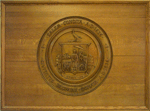Remond, John: Difference between revisions
No edit summary |
No edit summary |
||
| Line 16: | Line 16: | ||
*Vertical File in Salem Collection - '''Black History''' | *Vertical File in Salem Collection - '''Black History''' | ||
*[http:// | *[http://evergreen.noblenet.org/eg/opac/record/1958881?locg=63 Salem Women's Heritage Trail] by Bonnie Hurd Smith, p. 41-2 | ||
*[http://www.nps.gov/sama/historyculture/ugrr.htm African American History in Salem and Essex County] National Park Service Pamphlet (downloadable) | *[http://www.nps.gov/sama/historyculture/ugrr.htm African American History in Salem and Essex County] National Park Service Pamphlet (downloadable) | ||
Revision as of 19:24, 15 January 2013
John Remond (1785-1874) ran a successful catering business on the ground floor of the Hamilton Hall in Salem. An immigrant from Curacao,in the Caribbean, he was politically active in the anti-slavery cause and school desegregation.
He began his career as a hairdresser. Later, with his wife's help, he became a caterer. He handled some of the most important fuctions in town, including the 200th anniversary dinner for Salem and a dinner for Pres. Andrew Jackson in 1833.
His daughter Sarah Parker Remond went on to become an internationally renowned antislavery lecturer.
His son Charles Lenox Remond was a gifted orator and was active in anti-slavery meetings. He started the Salem Anti-Slavery Society with his son Charles in 1834. A few months later, John's daughter Sarah helped organize the Salem Female Anti-Slavery Society.
John Remond, his wife Nancy and several of his children are buried in Harmony Grove Cemetery.
See Also
- Vertical File in Salem Collection - Black History
- Salem Women's Heritage Trail by Bonnie Hurd Smith, p. 41-2
- African American History in Salem and Essex County National Park Service Pamphlet (downloadable)
- "Progressions of the African-American community" Salem Evening News, Feb. 16, 2000, p.A3
- "Remembering MLK: Members of Salem family were early champions of civil rights movement" Salem News, Jan. 15, 2007, p. C7
